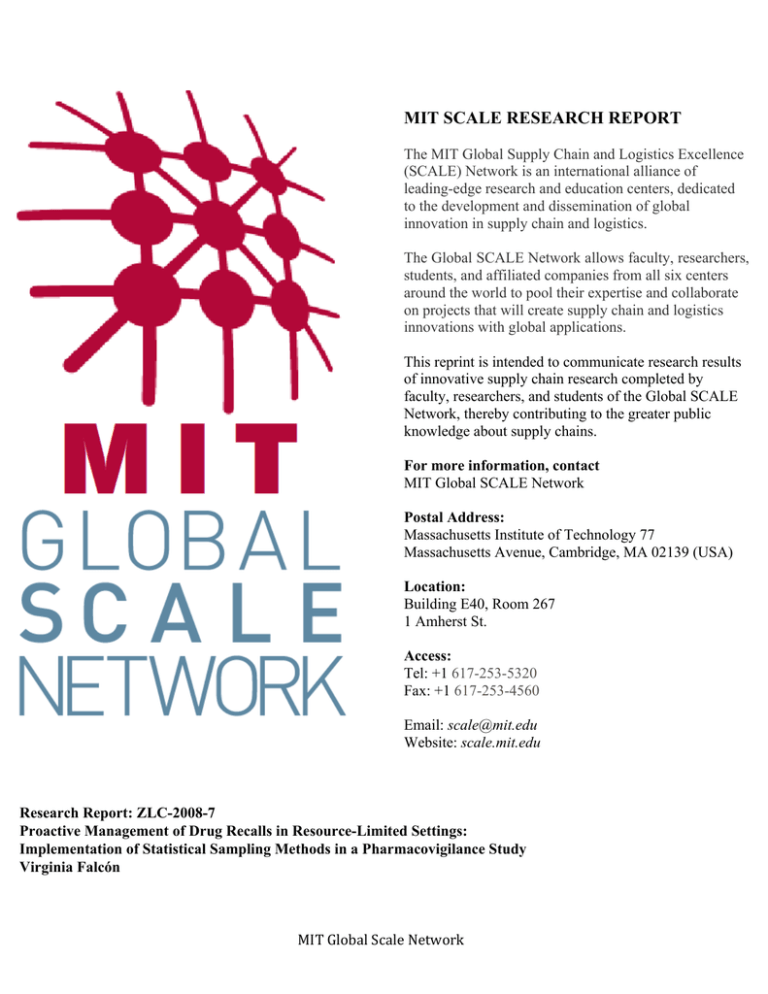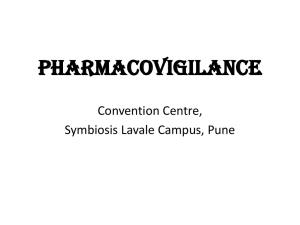MIT SCALE RESEARCH REPORT
advertisement

MIT SCALE RESEARCH REPORT The MIT Global Supply Chain and Logistics Excellence (SCALE) Network is an international alliance of leading-edge research and education centers, dedicated to the development and dissemination of global innovation in supply chain and logistics. The Global SCALE Network allows faculty, researchers, students, and affiliated companies from all six centers around the world to pool their expertise and collaborate on projects that will create supply chain and logistics innovations with global applications. This reprint is intended to communicate research results of innovative supply chain research completed by faculty, researchers, and students of the Global SCALE Network, thereby contributing to the greater public knowledge about supply chains. For more information, contact MIT Global SCALE Network Postal Address: Massachusetts Institute of Technology 77 Massachusetts Avenue, Cambridge, MA 02139 (USA) Location: Building E40, Room 267 1 Amherst St. Access: Tel: +1 617-253-5320 Fax: +1 617-253-4560 Email: scale@mit.edu Website: scale.mit.edu Research Report: ZLC-2008-7 Proactive Management of Drug Recalls in Resource-Limited Settings: Implementation of Statistical Sampling Methods in a Pharmacovigilance Study Virginia Falcón MITGlobalScaleNetwork For Full Thesis Version Please Contact: Marta Romero ZLOG Director Zaragoza Logistics Center (ZLC) Edificio Náyade 5, C/Bari 55 – PLAZA 50197 Zaragoza, SPAIN Email: mromero@zlc.edu.es Telephone: +34 976 077 605 MITGlobalScaleNetwork ________________________________________________________ Proactive Management of Drug Recalls in ResourceLimited Settings: Implementation of Statistical Sampling Methods in a Pharmacovigilance Study Virginia Falcón EXECUTIVE SUMMARY ________________________________________________________ According to Article 2 of its constitution, the World Health Organization has a mandate from its Member States to develop, establish, and promote international standards with respect to food, biological, pharmaceutical and similar products. It was not until the disaster caused by thalidomide in 1961 that the first systematic international efforts were initiated to address drug safety issues. At that time many thousands of congenitally deformed infants were born as the result of exposure in utero to an unsafe medication promoted for use by pregnant mothers. Recent drug recall cases as VIOXX® and Viracept ®, show the importance of conducting post-marketing studies to assess drug safety and tolerability on a continuous basis to control for potential Adverse Drug Reactions (ADR). VIOXX® was withdrawn from the market in 2004 because there was sufficient evidence that the drug raised the risk of myocardial infarction. Pharmacovigilance is described by the WHO as the science and activities relating to the detection, assessment, understanding and prevention of adverse effects or any other possible drug-related problems. ADRs are said to account for 3% of deaths in the developed world, where more reliable mechanisms and structures are in place to ensure drug safety. In the recent years there have been significant increases in funding for the development of new formulations for “Drug Neglected Diseases” as disease burden and resistance to previous formulations (in the case of malaria) have increased. Many international, public, private and philanthropic organizations are devoting significant amounts of funding to the development of new drugs (more than US$250 million in 2006) as well as to subsidies and other strategies to increase the degree of coverage for these vital treatments. The constrained conditions in which these treatments are being taken include: patients might take the medication without a prescription, or without any interaction with qualified physicians or health professionals; lack of information or effective communication in drug safety and tolerability; weak or nonexistent formal structures for surveillance and drug monitoring. Thus it is of primary importance to invest in surveillance and safety assessment studies and also to reinforce the existent capabilities of a country to ensure drug safety. Executive Summary, MIT-Zaragoza Master’s Thesis, 2008 1 Proactive Management of Drug Recalls in Resource-Limited Settings When conducting pharmacovigilance studies one aims to establish a causal relationship between a certain Adverse Event (AE) and a given treatment. The dilemma of missing counterfactuals is that one cannot observe both scenarios of the individual under treatment and without it, which would be needed to conclude beyond reasonable doubt that the given AE was caused by the treatment and not by any background variable. Therefore, the design of an observational study should include strategies to control for the effect of confounding variables. This could help to isolate the effects of the drug itself, or block the effect of the other attributes, in order to assess direct cause-effect relationships. This research looks into design strategies for a country-wide Cohort Event Monitoring study on pharmacovigilance from a sampling perspective, to control for confounders and achieve a certain degree of statistical robustness by Determining a cohort size: This research explores different methodologies to determine the optimal size of a cohort of patients in order to draw statistical inferences with a certain confidence level. Proposing methods to reduce biases: If a sampling strategy different from pure random sampling is selected, what are the potential biases in the sample and how could one could reduce them when designing a study? Designing a sampling strategy: Once a cohort size is targeted, how to collect that data in order to extrapolate the results for a whole population and how to control for confounding factors. This is achieved by techniques such as cluster sampling and stratified sampling to select sentinel sites for AEs data collection. Once the framework was built, a case study based on field research by the author for the implementation of a Cohort Event Monitoring study in Tanzania was developed. Different sampling strategies were applied and compared in order to further evaluate the applicability and robustness of the techniques proposed. The models were developed using the mathematical programming language LINGO by solving integer optimization programs that aimed to reduce the number of sentinel sites selected while fulfilling a target cohort size and achieving a significant level of representativeness of the country’s population. That is, according to a certain criteria such as demographics, incidence of disease, socio-economic profile, and so forth, select sentinel sites that would reflect the diversity of a population. Other statistical analysis tools such as SPSS were used in the intermediate data analysis phases in order to develop these models. This work shows that the utilization of statistical sampling techniques commonly used in market research, quality control or political polling is also viable and applicable to pharmacovigilance. Moreover the use of such techniques would positively impact the credibility of the study and the robustness of its results. Executive Summary, MIT-Zaragoza Master’s Thesis, 2008 2







